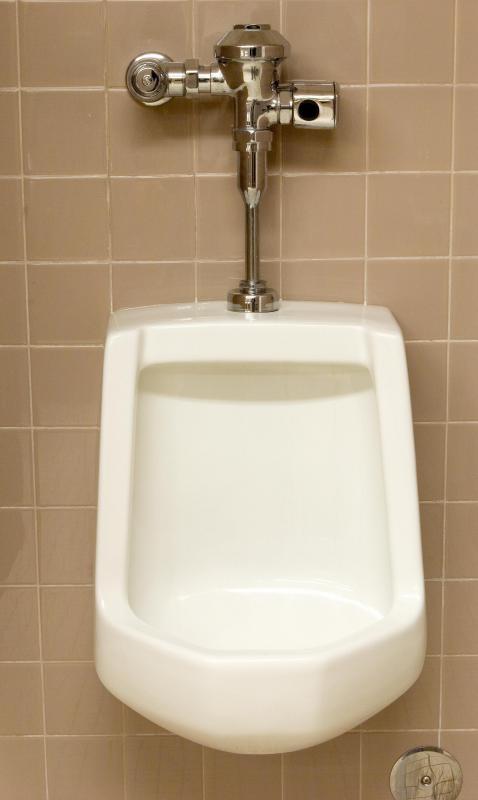At HomeQuestionsAnswered, we're committed to delivering accurate, trustworthy information. Our expert-authored content is rigorously fact-checked and sourced from credible authorities. Discover how we uphold the highest standards in providing you with reliable knowledge.
What Is a Toilet Flush Valve?
A toilet flush valve may take a number of different forms, though they are all designed to deliver water into a toilet bowl. Many types allow this water to pass from a cistern into the bowl, though there are also tankless toilet variants that use a high-pressure valve. Cistern-type toilets can use a flapper valve, a siphon-type valve, or even a high-pressure assist. In any case, by introducing a large amount of water into the toilet bowl, the flush valve can cause the commode to empty its contents through a siphoning effect.
Flapper-type toilet flush valves are common in the US and many parts of Europe. This type involves a rubber or plastic stopper that is seated over the water outlet to the toilet bowl. When the toilet is flushed, this flapper is lifted off the water outlet and allowed to float in the water contained in the cistern. Then, as the water flows out into the toilet bowl, the flapper gradually moves back into place. When the tank refills, the flapper is held in place via water pressure.

Siphon-type toilet flush valves are typically found in places like the United Kingdom (UK). This type of flush valve utilizes a siphoning action to provide water from a cistern to the toilet bowl. Traditionally, this involved a tank mounted high above the toilet, though newer designed allow the cistern to be much lower. These are known as close coupled designs. Siphoning flush valves may provide the benefit of a lower chance of water leaking from the cistern into the bowl and being wasted.

Another type of toilet flush valve uses a high-pressure assist. This system is often used in toilets that have normal-looking cisterns, though a pressure vessel may be placed inside. This container can then be filled with pressurized water that is introduced to the toilet bowl with great force when the toilet is flushed. The efficiency of this pressurized flow can result in the toilet using less water per flush.

A tankless design of flush valve also exists. This version generally involves introducing high-pressured water into the bowl, and is often used in commercial and other public, high-traffic installations. Useful for both urinals and traditional toilets, this type of toilet flush valve allows the unit to be used again immediately after being flushed, as there is no tank or cistern that must fill to provide the flushing action.
AS FEATURED ON:
AS FEATURED ON:















Discussion Comments
I think it would be strange to have a siphoning toilet valve and a cistern high above the toilet bowl. I am so used to having the tank sit right on top of the bowl, and I would feel like part of my toilet were floating if it were up above it!
Aren't people afraid that the cistern might fall off the wall? Nothing would be more terrifying and disgusting than to be sitting on the toilet and have your cistern fall and burst open, spilling water all over your back.
I think I will stick to the flapper valve design that I've always known. That's what every family I have ever visited here in the United States has in their bathroom, so it's good enough for me.
I had never looked inside my toilet tank until it started to overflow one day. It just kept flushing and flushing, and the water was slowly rising to the top.
I opened the tank and saw that a flap was hanging up above the hole. I had always heard that jiggling the handle might work to stop the flushing, so I tried it.
I saw that jiggling it made the flapper move up and down a little, and I figured that the two must be connected. So, it seemed reasonable that pushing the flap down on top of the hole would make the flushing stop.
I did this, and I was so relieved that it worked. I was happy that I figured it out before my floor got flooded with water. It would have been embarrassing to have had a plumber come in there and show me how simple it would have been to fix.
@kylee07drg – They actually do have a valve, and they rely on it for the process to work. My brother is a janitor, and he once told me how the tankless toilets in the building where he works function.
Whether someone flushes it by pushing a handle or it flushes on its own, the valve opens and lets in water with a lot of pressure behind it. This is why public toilets are so loud.
The water comes through a line that can be installed in the floor or the wall. It's just a water supply line, and when the valve opens, the pressurized water rushes in.
After a certain amount of water has flushed through the bowl, the valve closes automatically. This is when the flushing stops.
So, if a tankless toilet does not have a valve or a tank, where does the water come from? It seems that every toilet in a department store restroom or movie theater is tankless these days, and their function is a bit of a mystery to me.
I know they don't have a valve, because often, there isn't even any handle to push to activate the flush. Many of them rely on the sensor that can tell when you move away from the toilet, and then they flush on their own.
Because I don't know exactly when it will decide to flush, I have never been able to look at it at just the right moment to see what is going on. Is anyone else here confounded by this?
Post your comments